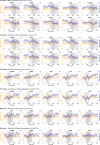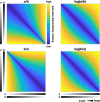Finding structure during incremental speech comprehension
- PMID: 38577982
- PMCID: PMC10997333
- DOI: 10.7554/eLife.89311
Finding structure during incremental speech comprehension
Abstract
A core aspect of human speech comprehension is the ability to incrementally integrate consecutive words into a structured and coherent interpretation, aligning with the speaker's intended meaning. This rapid process is subject to multidimensional probabilistic constraints, including both linguistic knowledge and non-linguistic information within specific contexts, and it is their interpretative coherence that drives successful comprehension. To study the neural substrates of this process, we extract word-by-word measures of sentential structure from BERT, a deep language model, which effectively approximates the coherent outcomes of the dynamic interplay among various types of constraints. Using representational similarity analysis, we tested BERT parse depths and relevant corpus-based measures against the spatiotemporally resolved brain activity recorded by electro-/magnetoencephalography when participants were listening to the same sentences. Our results provide a detailed picture of the neurobiological processes involved in the incremental construction of structured interpretations. These findings show when and where coherent interpretations emerge through the evaluation and integration of multifaceted constraints in the brain, which engages bilateral brain regions extending beyond the classical fronto-temporal language system. Furthermore, this study provides empirical evidence supporting the use of artificial neural networks as computational models for revealing the neural dynamics underpinning complex cognitive processes in the brain.
Keywords: EEG; MEG; deep language models; electroencephalography; human; incremental speech comprehension; magnetoencephalography; neuroscience; parsing; sentence structure.
© 2023, Lyu et al.
Conflict of interest statement
BL, WM, YF, LT No competing interests declared
Figures




























Update of
- doi: 10.1101/2021.10.25.465687
- doi: 10.7554/eLife.89311.1
- doi: 10.7554/eLife.89311.2
Similar articles
-
Neural dynamics of semantic composition.Proc Natl Acad Sci U S A. 2019 Oct 15;116(42):21318-21327. doi: 10.1073/pnas.1903402116. Epub 2019 Sep 30. Proc Natl Acad Sci U S A. 2019. PMID: 31570590 Free PMC article.
-
Neural Evidence for the Prediction of Animacy Features during Language Comprehension: Evidence from MEG and EEG Representational Similarity Analysis.J Neurosci. 2020 Apr 15;40(16):3278-3291. doi: 10.1523/JNEUROSCI.1733-19.2020. Epub 2020 Mar 11. J Neurosci. 2020. PMID: 32161141 Free PMC article.
-
Balancing Prediction and Sensory Input in Speech Comprehension: The Spatiotemporal Dynamics of Word Recognition in Context.J Neurosci. 2019 Jan 16;39(3):519-527. doi: 10.1523/JNEUROSCI.3573-17.2018. Epub 2018 Nov 20. J Neurosci. 2019. PMID: 30459221 Free PMC article.
-
[The neural encoding of continuous speech - recent advances in EEG and MEG studies].Sheng Li Xue Bao. 2019 Dec 25;71(6):935-945. Sheng Li Xue Bao. 2019. PMID: 31879748 Review. Chinese.
-
A predictive coding framework for rapid neural dynamics during sentence-level language comprehension.Cortex. 2015 Jul;68:155-68. doi: 10.1016/j.cortex.2015.02.014. Epub 2015 Mar 4. Cortex. 2015. PMID: 25840879 Review.
Cited by
-
Shared functional specialization in transformer-based language models and the human brain.Nat Commun. 2024 Jun 29;15(1):5523. doi: 10.1038/s41467-024-49173-5. Nat Commun. 2024. PMID: 38951520 Free PMC article.
References
-
- Baayen RH. The CELEX lexical data base on CD-ROM. Academia Press; 1993.
MeSH terms
Grants and funding
LinkOut - more resources
Full Text Sources

